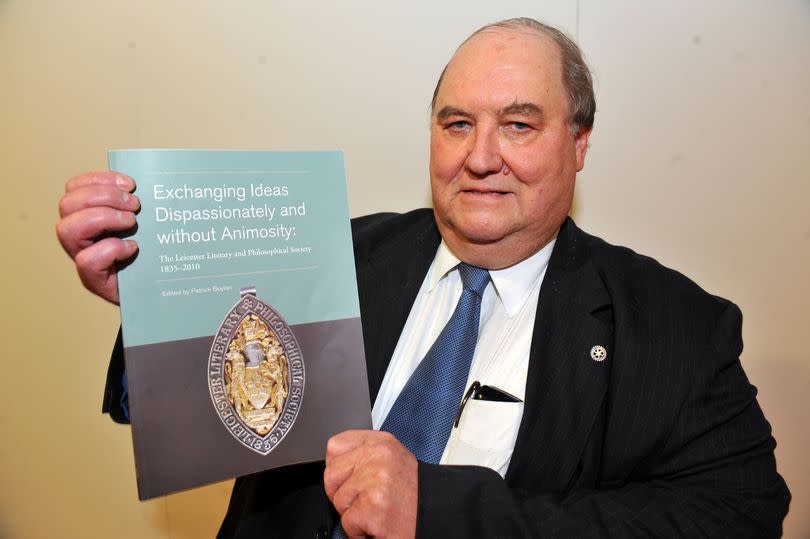Tribute to learned Hull man who spent his early years living in a railway carriage after his home was destroyed in the Blitz

A Hull man born weeks before the outbreak of the Second World War spent a number of years living in a railway carriage after his family home in the city was destroyed by the Blitz.
Patrick Boylan went on to become a professor of heritage policy and management and co-founder of Blue Shield, the international organisation set up to protect cultural heritage in times of war or natural disaster. Tribute has been paid to Prof Boylan, who has died at the age of 84.
The eldest of five sons born to Mary and Francis Boylan, Prof Boylan attended Marist College in Hull before studying geography and geology at the University of Hull, staying on for a teaching qualification. Within the walls of academia he developed a fascination for archaeology - one of his early digs was at Walkington in East Yorkshire, where he and his first wife, Ann Worsfold, enjoyed excavating at a Bronze Age barrow.
READ MORE:
Tribute to Don Bemrose - one of East Yorkshire’s best-known characters
Read more tributes to people who have died in Hull and East Yorkshire
He went back to his old school to teach geography but only until 1963, having decided he wanted to forge a career in the museum world. In a tribute to Prof Boylan, John Adamson, of publisher johnadamsonbooks.com, said: “Boylan’s earliest memories were of the war-torn city [of Hull] and the destruction of his family home in the Blitz.
“Old railway carriages which had been used as tourist coaches before World War II were requisitioned by the Corporation of Hull for local families rendered homeless by the Blitz. But the carriage that Boylan’s father, a master joiner, was able to buy from one of Hull’s leading timber merchants was not part of that scheme and had served as a dressing coach, probably at the turn of the 20th century.
“Painted a glossy turquoise on the outside, its interior was quite luxurious with mahogany panelling and an internal window, its glass etched with birds, and beneath it a magnificent sink set in a black-and-white marble surround. The newly-acquired carriage was towed on a trailer by horses the three miles from the railway station at Patrington to a broad meadow outside the village of Holmpton, some way from the cliffs facing the North Sea.
“The field belonged to a family of farmers his father had got to know while working on coastal defences at the beginning of the war. His father then built a flight of five wooden steps (the floor was 4ft from the ground) and added a lean-to on one side of the carriage to provide more room for his family.
“This work was rather hastily done, for he was called up to serve in the military. It was while living at Holmpton that the young Boylan developed a passion for fossils and interesting stones, scouring the nearby beach for them throughout his early childhood.”
Mr Adamson said: “When the war ended and Boylan’s father returned from Burma, the family rented a council house in Hull on the Preston Road. Boylan kept up his interest in fossils and stones, hoarding his growing collection under his bed until his father became worried that the ceiling would collapse. The carriage, which the family kept for many years, is now at Tanfield Railway Museum.”
In 1964, Prof Boylan became keeper of geology and natural history for Kingston upon Hull Museum – he also served as Hull Geological Society’s president from 1964 to 1967 - and in 1966 he was awarded a Museums Association in-service diploma with distinction. As keeper, he saw the consequences of the wartime destruction of Hull’s Central Museum in 1941 – one of his tasks was to identify surviving specimens, some of which were, as he put it, “heavily encrusted with melted lead” from the museum’s burning roofs.
Prof Boylan moved to Leicester in 1972, on his appointment as director of museums and art galleries, being made director of arts, museums and records for all of Leicestershire and Rutland, two years later. In 1990, Prof Boylan moved to City, University of London, where he remained as head of cultural policy and management until his retirement in 2004.
Hired by Unesco to undertake a written reappraisal of the 1954 Hague Convention for the Protection of Cultural Property in the Event of Armed Conflict, he published, in 1993, a 248-page document (the Boylan Report) that was to lead many more nations to adopt the Hague Convention and take active steps to ensure protection of their cultural property both in times of peace and war.
Mr Adamson said: “Alongside his museum and teaching career, Boylan became deeply involved with the Museums Association in an advisory capacity, and later with the International Council of Museums (ICOM), serving as chairman of many committees.
“While promoting the increasing importance of well-run museums as cultural repositories, he campaigned tirelessly for the protection of culture from damage or theft in times of war or disaster, whether natural or man-made. He viewed any such loss as ‘a loss for the whole of humanity’.”
Prof Boylan is survived by his second wife, Pamela, whom he married in 1993, their two sons, Matthew and John, and four sons, Andrew, Christopher, Mark and Peter, from his first marriage to Ann.

 Yahoo News
Yahoo News 
